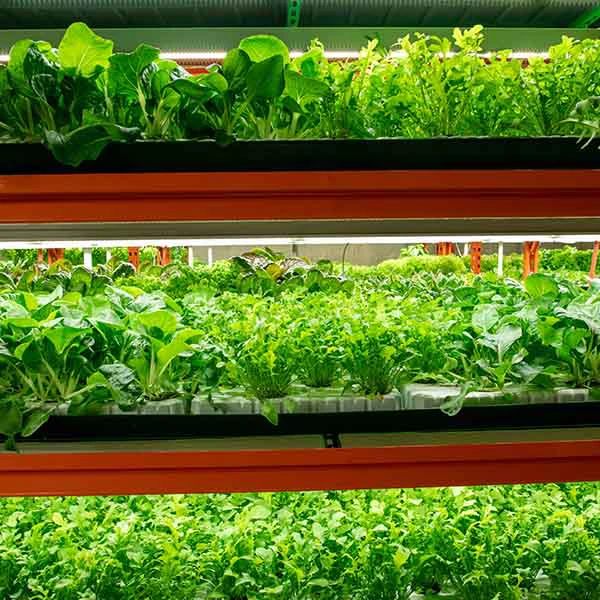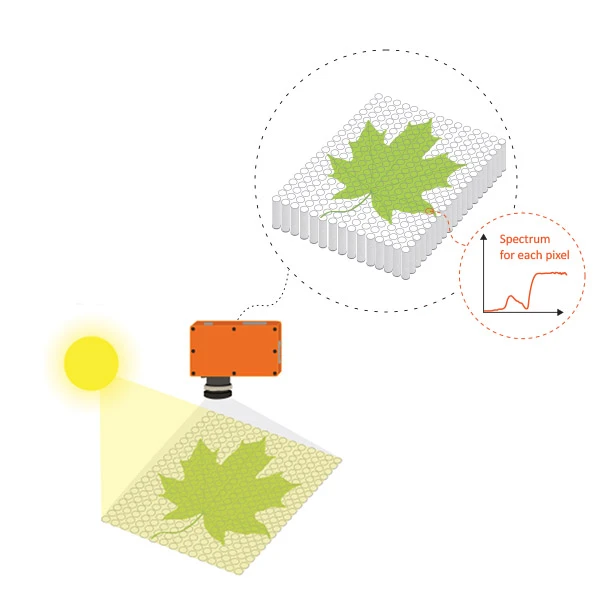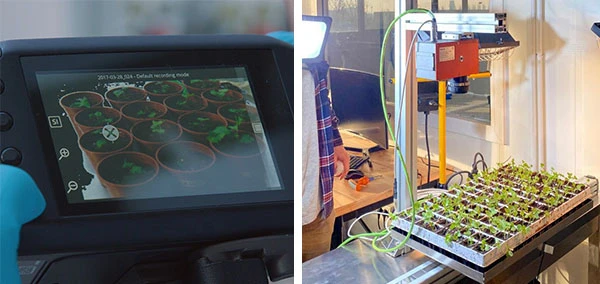การเพิ่มประสิทธิภาพการทำฟาร์มด้วยการถ่ายภาพไฮเปอร์สเปกตรัม

การทำฟาร์มได้รับความนิยมเพิ่มขึ้นอย่างรวดเร็วในช่วงไม่กี่ปีที่ผ่านมา เนื่องจากผู้คนจำนวนมากขึ้นเรื่อยๆ กำลังมองหาทางเลือกที่ยั่งยืนเกษตรกรรมแบบดั้งเดิมการปฏิบัติ ฟาร์มแนวตั้งแตกต่างจากฟาร์มแบบดั้งเดิมเนื่องจากปลูกพืชผลที่อัดแน่นเป็นชั้นซ้อนกันในแนวตั้ง โดยใช้สภาพอากาศเทียมที่สามารถควบคุมได้อย่างแม่นยำ ซึ่งหมายความว่าการทำฟาร์มแนวตั้งสามารถให้ผลตอบแทนสูงได้แม้ในพื้นที่ขนาดเล็ก เช่น โกดังและห้องปฏิบัติการ อย่างไรก็ตาม ค่าใช้จ่ายในการติดตั้งและการดำเนินงานค่อนข้างสูง และเพื่อให้บรรลุประสิทธิภาพ สภาพการเจริญเติบโตของพืชจะต้องดีที่สุดอย่างต่อเนื่อง นี่คือสิ่งที่เทคโนโลยีชอบการถ่ายภาพไฮเปอร์สเปกตรัม (HSI)มีบทบาทสำคัญใน

การถ่ายภาพไฮเปอร์สเปกตรัม
HSI เป็นเทคโนโลยีใหม่ที่มีการใช้งานมากขึ้นในหลายๆการวิจัยและทางด้านอุตสาหกรรมการใช้งานโดยเฉพาะในด้านของเกษตรกรรมและพืชพรรณ– HSI วิเคราะห์สเปกตรัมแสงที่กว้างผ่านการผสมผสานเทคนิคสเปกโทรสโกปีและการถ่ายภาพดิจิทัล เพื่อให้ได้ข้อมูลสเปกตรัมและเชิงพื้นที่ของวัตถุที่สามารถใช้เพื่อเพิ่มประสิทธิภาพการผลิตพืชผลได้ โดยนำเสนอวิธีการแบบไม่ทำลายในการติดตามและวัดพารามิเตอร์ทางกายภาพ เคมี และชีวภาพต่างๆ ในพืช ซึ่งอาจต้องใช้การวิเคราะห์ทางเคมีที่มีการทำลายล้างและช้า การใช้ HSI เพื่อหาปริมาณลักษณะพืชได้รับการบันทึกไว้อย่างดีในงานวิจัยหลายชิ้น มีการใช้กันอย่างแพร่หลายในการตรวจจับความเครียดทางชีวภาพและไม่ใช่ทางชีวภาพในพืชตลอดจนส่วนประกอบเชิงหน้าที่เช่นคลอโรฟิลล์แคโรทีนอยด์ แอนโทไซยานิน ฯลฯ นอกจากนี้ HSI ยังใช้ในการทำนายการมีอยู่ของธาตุอาหารหลัก เช่น การกระจายตัวเชิงพื้นที่ของไนโตรเจนทั้งหมดในต้นพริกไทย ปริมาณฟอสฟอรัสในขึ้นฉ่าย ชูการ์บีท และสตรอเบอร์รี่ หรือปริมาณโพแทสเซียมในชูการ์บีทและขึ้นฉ่าย ฯลฯ
ความยาวคลื่นสเปกตรัมที่ใช้ในการฟีโนไทป์ของพืช ได้แก่ การมองเห็น (VIS) ระหว่าง 400 นาโนเมตรถึง 700 นาโนเมตร อินฟราเรดใกล้ (NIR) ระหว่าง 700 นาโนเมตรถึง 1,000 นาโนเมตร และอินฟราเรดคลื่นสั้น (SWIR) ตั้งแต่ 1,000 นาโนเมตรถึง 2,500 นาโนเมตร เม็ดสีสังเคราะห์แสง เช่น คลอโรฟิลล์ ดูดซับแสงอย่างรุนแรงในช่วงความยาวคลื่น VIS โดยเฉพาะในพื้นที่สีน้ำเงินและสีแดง มีการดูดกลืนแสงน้อยกว่าในพื้นที่สีเขียวภายในความยาวคลื่น VIS ซึ่งสะท้อนแสงได้มาก ทำให้พืชมีลักษณะเป็นสีเขียว คลอโรฟิลล์ดูดซับแสงได้อย่างมีประสิทธิภาพจนถึงบริเวณ NIR ซึ่งแสงส่วนใหญ่สะท้อนแสง การเปลี่ยนแปลงการสะท้อนแสงอย่างกะทันหันสามารถสังเกตได้ภายในบริเวณเฉพาะระหว่าง VIS และ NIR (ประมาณ 680 นาโนเมตรถึง 730 นาโนเมตร) ที่เรียกว่าขอบสีแดง และโดยทั่วไปใช้ในการตรวจจับความเครียดของพืช ตัวอย่างเช่น การเปลี่ยนแปลงของความลาดเอียงของขอบสีแดงไปทางความยาวคลื่นที่สั้นลงจะบ่งบอกถึงความเข้มข้นของคลอโรฟิลล์ต่ำและระดับความเครียดที่เพิ่มขึ้นในพืช โดยทั่วไปปริมาณน้ำในพืชจะได้รับการวิเคราะห์โดยใช้ช่วงความยาวคลื่น NIR และ SWIR ซึ่งแสดงให้เห็นการสะท้อนที่รุนแรงใน NIR แต่การดูดซับที่รุนแรงใน SWIR จนถึงปัจจุบัน มีดัชนีพืชพรรณ (VI) จำนวนมากที่พัฒนาจากการศึกษาต่างๆ ที่นำเสนอแนวทางที่ง่ายและรวดเร็วในการวิเคราะห์ข้อมูลไฮเปอร์สเปกตรัม รวมถึง NDVI (Normalized Difference VI), mCARI (ดัชนีอัตราส่วนการดูดซึมคลอโรฟิลล์ที่ปรับเปลี่ยน), mARI (ดัชนีการสะท้อนกลับของแอนโทไซยานินที่ปรับเปลี่ยนแล้ว) ), REP (ตำแหน่งขอบสีแดง) ฯลฯ

ช่วงความยาวคลื่นสเปกตรัมสำหรับการถ่ายภาพไฮเปอร์สเปกตรัม
กล้องไฮเปอร์สเปกตรัมเฉพาะทางเพื่อการเกษตรและการทำฟาร์มแนวตั้ง
Konica Minolta Sensing ร่วมกับกลุ่มบริษัท Specim ซึ่งเป็นผู้บุกเบิกด้าน HSI นำเสนอผลิตภัณฑ์ที่มีความน่าเชื่อถือสูงและมีความละเอียดสูงหลายรายการสแกนเส้น กล้องไฮเปอร์สเปกตรัมที่สามารถรองรับการใช้งานการทำฟาร์มแนวตั้งที่หลากหลาย
กล้อง Specim IQ Hyperspectral
กล้องไฮเปอร์สเปกตรัมแบบพกพาที่ครอบคลุมช่วงความยาวคลื่น VNIR (ที่มองเห็นได้และอินฟราเรดใกล้)กล้องไฮเปอร์สเปกตรัมไอคิวเฉพาะสามารถรับข้อมูลไฮเปอร์สเปกตรัมได้อย่างรวดเร็วและง่ายดายในทุกสภาพแวดล้อม ไม่ว่าจะในร่มหรือกลางแจ้ง ด้วยการใช้งานที่เหมือนกล้องและเรียบง่าย พร้อมด้วยสแกนเนอร์ในตัว กล้องไฮเปอร์สเปกตรัม Specim IQ ช่วยให้ทุกคนตั้งแต่ผู้เริ่มต้นไปจนถึงผู้เชี่ยวชาญใน HSI สามารถดำเนินการ HSI ได้อย่างง่ายดาย ดูนี้วิดีโอและดูว่ากล้องไฮเปอร์สเปกตรัม Specim IQ ถูกนำมาใช้ในการตรวจจับการมีอยู่ของแอนโทไซยานินในพืชอย่างไร
กล้องไฮเปอร์สเปกตรัม Specim FX ซีรี่ส์
มีสามรุ่นที่แตกต่างกัน: กล้องไฮเปอร์สเปกตรัม VNIR Specim FX10, กล้องไฮเปอร์สเปกตรัม NIR Specim FX17 และ MWIR (อินฟราเรดความยาวคลื่นปานกลาง) กล้องไฮเปอร์สเปกตรัม FX50 กล้องไฮเปอร์สเปกตรัม Specim FX ซีรีส์เป็นตัวเลือกที่เหมาะสมที่สุดสำหรับการใช้งานทางอุตสาหกรรมและการวิจัยที่หลากหลาย เนื่องจากความเร็วและประสิทธิภาพที่โดดเด่น ตัวอย่างเช่น Agricola Moderna บริษัทเกษตรกรรมแนวตั้ง ใช้กล้องไฮเปอร์สเปกตรัม Specim FX10เพื่อตรวจสอบระดับไนโตรเจน ฟอสฟอรัส และโพแทสเซียมในผักใบเขียวและสลัด

กล้องไฮเปอร์สเปกตรัม Specim IQ (ซ้าย) และกล้องไฮเปอร์สเปกตรัม Specim FX10 (ขวา)
ได้รับความอนุเคราะห์จาก SPECIM, SPECTRAL IMAGING LTD.
นอกเหนือจากกล้องไฮเปอร์สเปกตรัมแล้ว Konica Minolta ยังนำเสนอโซลูชันเครื่องมือที่หลากหลายซึ่งสามารถสนับสนุนนักวิจัยและผู้ผลิตทางการเกษตรในการวิจัย การผลิต และการควบคุมคุณภาพเหล่านี้ได้แก่ การวัดค่าแสงสำหรับการวัดเอาต์พุตของแหล่งกำเนิดแสงเครื่องมือวัดสีเพื่อตรวจสอบคุณภาพและความสุกงอมของพืชผล ฯลฯ ลองดูโซลูชันเครื่องมือต่างๆ ของเราสำหรับอุตสาหกรรมการเกษตรที่นี่
หากต้องการความช่วยเหลือในการค้นหากล้องไฮเปอร์สเปกตรัมหรือโซลูชันที่เหมาะสมสำหรับการใช้งานด้านการเกษตรสาทารถติดต่อกับเราเพื่อรับคำปรึกษาฟรีทันที
